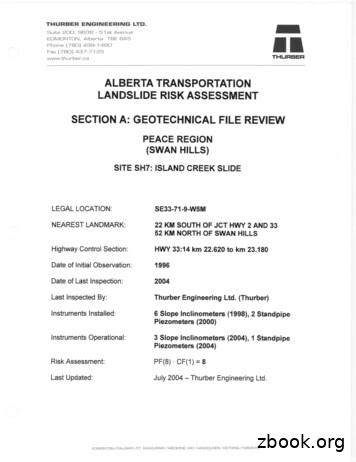Animal Leadership Activity - Alberta Health Services
ComprehensiveSchool HealthAnimal Leadership ActivityOverview and purposeInstructionsThis activity can be used to engage students in aconversation about how complex leadership canbe, different leadership styles and how people withvarious leadership styles can work together. Usethis activity in the classroom or with any group ofstudents (e.g., school health team members, sportsteams, school clubs).A. Large group introductory discussion (5–10 minutes)ParticipantsJunior and senior high school studentsTime needed60–75 minutesMaterials Animal pictures (included) “Attributes of Leaders” handout (included) Leadership quotations (included) Markers Flipchart paper1. Instruct students to think about someone in theirlife who they consider to be an excellent leader.This person may be someone that they know orsomeone who has influenced them.2. Have participants introduce themselves andshare who they identified as a leader in tenwords or less.3. Explain that one of the first hurdles to overcomein leadership is to understand that not allleaders fit the stereotype or have the sametraits. Leadership is complex, and can include abroad range of people, actions and abilities.B. Large group discussion: definitions of leadership(10 minutes)1. Explain to students that leadership has manydefinitions and interpretations. Ask studentvolunteers to read out the leadership quotationsposted around the room.2. Have students answer the following questions:What do these quotations have in common? Hang the leadership quotations around the room.»» Possible answer: All quotations recognizethat leadership occurs in the context of agroup or when people are working together. Stick the animal pictures onto flipchart paper andput them up on walls around the room. Ensure thatmarkers are available at each picture.What are some styles of leadership that you’veseen or experienced (e.g., the way that a leaderacts)? Can you give an example?Leader preparation before the activityNotes/adaptations Student leaders can facilitate all or parts of thisactivity if they are given time to prepare. Depending on the time available, this activity canbe completed over two sessions (Parts A–C at onetime, and Parts D–E at another time).»» Possible answer: Leadership styles occuron a continuum. Hierarchical leadershipis a top‑down style of leadership, whereone person is largely in charge of makingdecisions. Shared leadership is a democraticstyle of leadership that involves usingdifferent people to lead and make orinform decisions at different times.1
Is one of these leadership styles preferred overthe other? When might each style be moreappropriate?»» Possible answer: Hierarchical leadershipmight be more appropriate during anemergency, when there is no time to requestinput and decisions must be made quickly(e.g., evacuation during a fire). Democraticleadership might be more appropriate whena leader needs to get buy-in from a groupabout a decision (e.g., a teacher usingstudent input to create a set of classroomrules). In many cases, a leader may needto use both styles and act across thecontinuum of leadership styles.3. Explain to students that many people have apreferred leadership style that they use in aleadership role. It is important to recognize yourown preferred style, and respect the styles ofthose around you.C. Large group discussion: attributes of a leader (10 minutes)1. Distribute the “Attributes of Leaders” handoutand ask students to read it. Instruct them tocircle any characteristics they would use todescribe themselves, and add any additionalcharacteristics at the bottom of the worksheet.2. Ask students the following questions:What words stood out to you?What attributes struck you as being especiallyimportant? Why?What attributes do you think would be the mostchallenging to develop or apply?What leadership attributes did you add to thelist?Are there any attributes you would like todevelop in the future? How could you do this?D. Personal leadership style exercise (25–30 minutes)1. Just as we are individuals in other ways, we alsodiffer in our leadership styles. This exercise helpsstudents examine their own leadership styles, andreflect on their implications in different situations.2. Invite the group to think about the qualities ofeach animal and decide whether their leadershipstyle is most like a dog, cat, snake, lion, deer ormouse. Note: The purpose of this activity is to haveparticipants identify these qualities on their own;definitions are likely to vary from group to group.23. Instruct students to go to the animal that mostreflects their leadership style.4. In small groups (based on each animal), havestudents use the flipchart to write down thequalities of that animal (allow 10–15 minutes fordiscussion). Tell students that they may switchgroups if they feel the qualities of another animalare more consistent with their leadership style.5. Have each small group present back to thelarger group.6. After all the groups have shared, ask eachstudent to select one of the other animals in theroom and respond to the following questionsby writing their answer on a piece of paper(alternately, have students pair up with adifferent animal and discuss these questions):Given my qualities and the qualities of thisother animal, how can I be better prepared towork well with that animal?Why is it important to understand and see thedifferences between my animal’s leadershipqualities and those of another animal?Do I ever need to take on the leadership styleof another animal? When? Why?7. Have some or all of the students share theirresponses to the questions in step 6 with thelarger group.E. Large group debrief discussion (10–15 minutes)1. Facilitate a discussion with students using thefollowing questions:How did your group approach the tasksassigned?»» Were your actions reflective of yourleadership style/animal?»» Were there any challenges?»» Was everyone engaged in the conversation?How did you feel when your animal was beingdiscussed by the other students?What insights did you gain about your ownleadership style?How can you apply what you learned as youmove forward?SourceCreating Sustainable and Active Leadership, originally adapted fromThe Innovation Center for Community and Youth Development,National Network for Youth, Youth Leadership Institute.535R 2014
Deer3
Dog4
Cat5
Mouse6
Snake7
Lion8
Attributes of LeadersBelow is a list of characteristics that are sometimes used to describeleaders. Circle the attributes that you would use to describe yourself.Use the space at the bottom to add other leadership attributes thatyou feel are important. Physical vitality and stamina Intelligence and ability to make wise decisions Willingness (eagerness) to accept responsibility Ability to complete tasks successfully Understanding of others in the group and their needs Skill in dealing with people Need to achieve Capacity to motivate Courage, resolution and steadiness Capacity to win and hold trust Capacity to manage, decide and set priorities Confidence Ability to speak up and take control when necessary Adaptability and flexibility of approachAdditional attributes:9
“If you can dreamit, you can do it.”Walt Disney10
“Fail to honour people,they fail to honour you;but of a good leader,who talks little,when his work is done,his aim fulfilled,they will all say:We did this ourselves.”Lao Tzu11
“True leadershipis the art ofchanging a groupfrom what it is towhat it ought to be.”Virginia Allen12
“If you are a blockahead of theparade you’releading it. If you aretwo blocks aheadof the parade, youaren’t even in it.”Dr. Lawrence Kratz13
“Time is neutraland does notchange things.With courage andinitiative, leaderschange things.”Jesse Jackson14
“Leaders mustencourage theirorganizations todance to formsof music yetto be heard.”Warren G. Bennis15
“Do what you doso well that theywill want to returnto see it again andbring their friends.”Walt Disney16
“Successfulleadership is notabout being toughor soft, sensitive orassertive, but abouta set of attributes.First and foremostis character.”Warren G. Bennis17
“Mountaintopsinspire leaders,but valleysmature them.”Winston Churchill18
“Think big, act big,and the resultswill be big.”Anonymous19
“Our only limitto the realizationof tomorrow willbe our doubtsof today.”Franklin D. Roosevelt20
“A leader takespeople where theywant to go. A greatleader takes peoplewhere they don’tnecessarily want togo, but ought to be.”Rosalyn Carter21
“Do not followwhere the pathmay lead.Go instead wherethere is no pathand leave a trail.”Ralph Waldo Emerson22
“Never troubleanother forwhat you cando for yourself.”Thomas Jefferson23
“All of our dreamscan come trueif we havethe courage topursue them.”Walt Disney24
» Possible answer: Leadership styles occur on a continuum. Hierarchical leadership is a top‑down style of leadership, where one person is largely in charge of making decisions. Shared leadership is a democratic style of leadership that involves using different people
EDMONTON, Alberta TOE 6A5 Phone (780) 438-1460 Fax (780) 437-7125 www.thurber.ca ALBERTA TRANSPORTATION LANDSLIDE RISK ASSESSMENT MR THURBER . Alberta (83-0)." 5. Alberta Research Council, 1976. "Bedrock Topography of the Lesser Slave Lake Map Area, NTS 83 0, Alberta." 6. University and Government of Alberta, 1969. "Atlas of Alberta."
Alberta Native Friendship Centres Association . School of Public Health, University of Alberta Ever Active Schools Kainai Board of Education Alberta Health Services Alberta Recreation and Parks Association Nature Alberta Future Leaders Program, Alberta Sport, Recreation, . and gaming. It is through these opportunities that education occurs.
Alberta Interpretation Act Timelines outlined within the Bylaw shall be complied with pursuant to the Alberta Interpretation Act, as amended, Alberta Building Code In the case where this bylaw conflicts with the Alberta Building Code, the Alberta Building Code shall prevail, Alberta Land Titles
ALBERTA Philip Lee 1 and Cheryl Smyth 2 1 Forest Resources Business Unit, Alberta Research Council, Vegreville, Alberta Canada T9C 1T4. Present address: Senior Research Associate, Integrated Landscape Management Program, Department of Biological Sciences, Biological Sciences Building, University of Alberta, Edmonton, Alberta, Canada T6G 2E9.
1 Alberta Research Council, P.O. Bag 4000, Vegreville, Alberta T9C 1T4 2 Present address: Alberta Conservation Association, 6th Floor, Great West Life Building, 9920-108 Street, Edmonton, Alberta T5K 2M4 3 Alberta Conservation Association, Northwest Business Unit, Bag 9000,
6 Government of Alberta Report Back: Addiction and Mental Health Stakeholder Meetings Appendix - List of Attendees Edmonton (August 8, 2018) - 53 attendees in total Metis Indian Town Alcohol Association Alberta Education - Indigenous Mental Health Alberta Community Council on HIV Office of Alberta Health Advocates (2 attendees)
animal. Say the good qualities of the 2nd place animal over the 1st place animal. List why the 2nd place animal does not win the class. (bad qualities) Say why 2nd place animal beats 3rd place animal by stating only the good qualities of the 2nd place animal. Say the good qualities of the 3rd place animal over the 2nd place animal.
criminal justice systems in terms of homicide cases solved by the police, persons arrested for and per-sons convicted of homicide. Bringing the perpetrators of homicide to justice and preventing impunity for those responsible for lethal violence is a core responsibility of the State. Indeed, there is international recognition1 that the State is required to provide judicial protection with .






















